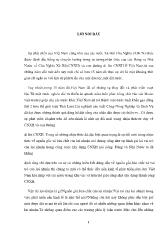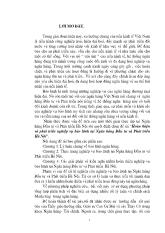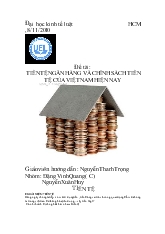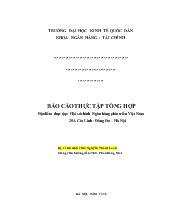How to communicate effectively with foreign colleagues in foreign organizations and companies
- Người chia sẻ :
- Số trang : 65 trang
- Lượt xem : 11
- Lượt tải : 500
- Tất cả luận văn được sưu tầm từ nhiều nguồn, chúng tôi không chịu trách nhiệm bản quyền nếu bạn sử dụng vào mục đích thương mại
Bạn đang xem trước 20 trang tài liệu How to communicate effectively with foreign colleagues in foreign organizations and companies, để xem tài liệu hoàn chỉnh bạn click vào nút DOWNLOAD LUẬN VĂN ở trên
1.1. Rationale of the study Communication is the essential need of human. It has incessantly improved and developed during our whole life. Communication helps us to acquire and increase knowledge from the outside world and strengthen relations between people, especially those from different cultures and countries. In workplace, many organizations are losing valuable business opportunities because they have failed to recognize the fundamental importance of effective communication. It is communication breakdown that is at the root of conflicts or misunderstanding among colleagues. Staff’ success also depends not only on professionalism and diligence but their individual relationships and communication skills as well. In Vietnam nowadays, the country is integrating into the global village. More and more foreign companies and organizations have been sprung up like mushroom. Therefore, communication skills with foreign counterparts play an important role in enhancing the efficiency and effectiveness of their work. Vietnamese staff’s ability to communicate with foreigners has become a subject of discussion; however, few studies on it have been carried out. That is the reason why I chose the topic for this thesis as “How to communicate effectively with foreign colleagues in foreign organizations and 1.2. Objectives of the study The study aims to: • Provide an overall idea about communication • Investigate how Vietnamese staff communicate with their foreign counterparts • Find out how to communicate more effectively with foreign colleagues Research questions of the study include the followings: • What is communication process? • What are communication types? • What are communication forms? • What are communication styles? • What are principles of effective communication? • What are benefits of effective communication? • What are consequences of poor communication? • What are barriers to effective communication with foreign colleagues? • How do Vietnamese staff communicate with their foreign colleagues at workplace? • What are the best ways to communicate with foreign colleagues in foreign organizations and companies? 1.3. Scope of the study I carried out a small-scaled survey with 77 respondents. This survey focused on investigating the oral/spoken communication performance of Vietnamese staff with their foreign colleagues in foreign organizations and companies in Hanoi only due to time limitation. Such factors as social status and gender were included in the questionnaires. Basing on the findings drawn from 77 informants, the writer made some tentative conclusions about what are the best ways to communicate with foreign colleagues. 1.4. Methodology of the study This thesis was written based on both primary and secondary data. A wide range of materials regarding communication and relating researches were studied such as the published books and web documents. The research methods I used were descriptive and quantitative ones. A survey on how Vietnamese staff communicate with their foreign colleagues was conducted in some foreign organizations, other limited and private companies, International Agency and Institution of Environmental Technology. A survey questionnaire was carried out to collect data. Description, analysis, and statistics were used in processing and interpreting data. Details of studying methods will be further presented in chapter III. 1.5. Structure of the study The study consists of 5 chapters: Chapter 1: Introduction – provides an introduction of rationale, objectives, scope, methodology and structure of the study. Chapter 2: Theoretical background – presents an overview of studies on communication. In this notion of communication, the process of communication and communication types, forms and styles are presented. Besides, principles of effective communication, benefits of effective communication, consequences of poor communication and barriers to communication are also included in this chapter. Chapter 3: Methodology and analysis – is concerned with a description of studying methods and the results as well as the analyses of the survey. Chapter 4: Discussions and some recommendations on how to communicate effectively with foreign counterparts in foreign organizations and companies – looks at the discussion about the survey and puts forward some tips to have a better communication with colleagues from other countries. Chapter 5: Conclusion – discusses conclusion and limitations of the study as well as suggests some directions for further study.




